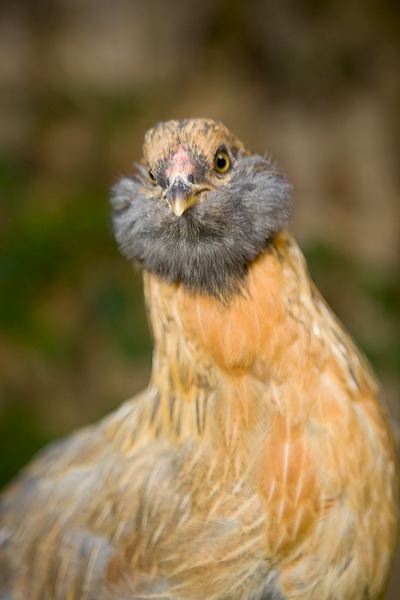
Edie with her beard
I’ve been so ashamed to admit that my pampered, pet chickens have mites that until recently I haven’t told a sole. I’ve spent many, many late night hours searching through the archives of backyardchicken.com educating myself on how to spot them and how to get rid of them. There are many different schools of thought, which, although helpful, has added to my confusion on how to deal with the problem.
My battle started a few months ago when I noticed Edie’s luxurious beard getting a little mangy looking. I bought a bag of diatomaceous earth and sprinkled it liberally inside their coop. Diatomaceous earth or DE for short, is fossilized diatoms or a hard-shelled algae. It’s tiny edges abrade soft-bodied animals that come into contact with it causing them to die of dehydration. You use food-grade DE with chickens (non-food-grade is lethal) to kill mites, lice and to deter flies. Some gardeners also sprinkle the stuff around their plants to protect them from slugs. When using DE, you must wear a dust mask and eye protection.
I also read that you need to dust your chickens. What the heck does a city girl know about how to dust a chicken?! I immediately turned to the internet, which has never let me down until this point. I was told to hold them upside down by their legs and sprinkle the DE all over them. Under wings, by their vent (chicken speak for poop shoot) and around their neck. You can put the DE in the foot of a stocking and use it like a powder puff. I thought for sure that YouTube would have a video showing me how to do that, but they didn’t. They have lots of videos of chickens rolling around in the dirt taking a voluntary dust bath in case you are interested in that? No? Okay. I also read that you can put DE in a plastic bag, put the chicken into the bag up to its neck and then just shake the bag. One person on the chicken forum made the connection to Shake N’ Bake and I can’t get that image out of my mind now. Plus I can’t figure out how to do that without strangling your chicken.
We then proceeded to have the rainiest June I can remember. Every time I dusted the chickens (which consisted of me sprinkling DE on them and then trying to massage it under their feathers) and their run it would rain. DE doesn’t work when it gets wet. Gah. Edie started to look mangier and her egg production fell off. When she layed eggs, they were strange – bumps on the shells, soft-shells, no shells. She didn’t act sick, but I knew that there was a problem. I bought some Poultry Protector and sprayed it in their coop and on them. Poultry Protector is a natural enzyme that kills mites, but isn’t harmful to the birds or the environment.
But the rain continued and I didn’t get rid of the mites. Or at least Edie’s neck and eggs still were in bad shape. Getting rid of mites is a bit like fighting an invisible boogey man. I could never see them, but I knew they were there. I decided to use different products. I stepped up a rung on the toxic spray ladder and bought some permethrin. I draw the line at Sevin, which a lot of people use to great success. What killed the Sevin for me was the part on the warning label that says it kills bees. I couldn’t be a part of the collapse of the honey bee population. Permethrin is derived from plants, which makes it sound less toxic, although it too has a pretty long list of warnings on the bottle. I sprayed the coop after I cleaned it thoroughly and I also sprayed the wood chips in the run. I also sprayed a little on the girl’s tushes. I washed Edie’s tush because it was getting a little dirty looking. I was horrified to see lots of missing and broken feathers. See thoroughly gross photo…
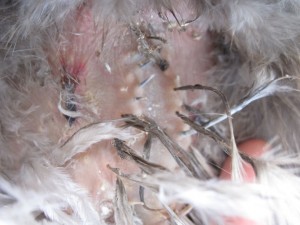
broken and missing vent feathers
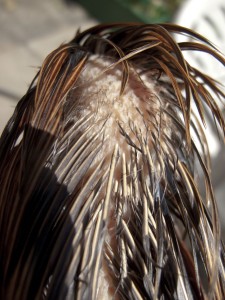
feathers missing on the back of Edie’s neck
I also bought flea and tick shampoo and powder. My toxic arsenal was getting larger!! They both contain permethrin in their ingredient lists. A lot of chicken keepers have success bathing their chickens in flea shampoo, so I thought I would give that a try. You see, you have to continue battling the chicken mites for a while to break their egg cycle. These products kill the mites, but not the eggs, so you have to do a second or third (or in my case 45th) round to make sure you catch all the hatching mites. The discouraging part is that even though you might kill all the mites in your immediate coop area, some mites can live for 6 weeks off their host and can come back to re-infest your flock.
So here are some photos of Edie after her flea bath. I put her in my daughter’s Lego tub and then lathered her up on the patio. I rinsed her several times with warm water to get the shampoo off of her. You have to make sure when doing this that your bird doesn’t get chilled. Even though it was a very warm and sunny day, I could feel her shivering a bit. I toweled her off and held her in the sunshine until she was dry. As you can see, she was not happy at all about being shampooed.
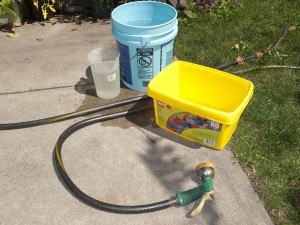
chicken washing station
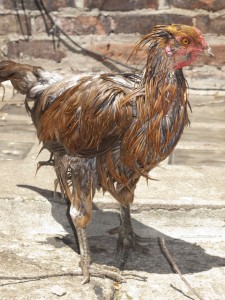
an angry wet hen
I also just ordered plastic roosting posts from Omlet as I read that mites can hide in the tiny cracks in wooden posts. When those arrive I will do another entire breakdown, scrubbing and dusting of their coop and run. Edie’s neck still looks very mangy, but I think I see some feathers growing in. I’ve been feeding all the girls yogurt (probiotics) and cat food (protein to help re-grow feathers), which they devour with gusto.
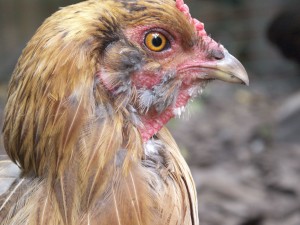
This has been a huge pain in the neck for both me and the hens and I hope I will get rid of the mites soon. Don’t worry about coming over, chicken mites don’t like humans. It’s just the thought of them that makes you itchy. And if someone wants to produce it with me, I think YouTube needs a video of how to dust a chicken.
Update: Since this post, I’ve learned that the mites do in fact bite humans. Many of my readers can vouch for that! And I did find YouTube videos for dusting a chicken. You can see some on my follow-up post here:
http://www.brooklynfeed.com/2011/05/dusting-your-chicken-for-mites/

I’m not sure what the availability of Ivomectin is in Australia. Try searching online to see if there’s a source via the internet in Australia.
Since making this post, I have learned from readers that mites do attack humans. Most sources online state otherwise. But enough of that, let’s figure this out. Basically you can treat your home like you would for fleas to get rid of the mites. You may be able to put some sort of flea spray on your arms while handling your chickens. Just read the label to make sure it’s okay for people and skin first please! You can wash your hens in a flea shampoo for pets, but I found that didn’t help in the long run. Besides they don’t really like getting wet and you have to make sure they dry without getting chilled.
Many people use Sevin dust with great results. I didn’t like all the environmental warning labels on the box. Too scary for me.
You should clean out any and all bedding and straw. Never use straw, by the way. Use hay, which doesn’t have a hollow shaft – the perfect hiding place for mites. I just had a reader get an infestation from a bale of straw she put in.
You can use diotomaceous earth (food grade only!) to dust your hens. Take a peek at the videos on this post to see how it’s done.
http://www.brooklynfeed.com/2011/05/dusting-your-chicken-for-mites/
Let me know what you find in your area and how you are doing in the war against the awful critters.
I am currently fighting this AWFUL battle and I am about at my wit’s end! I called a retired ag teacher and he said to try Sulpher on them. He said that I should be careful and not get it in my eyes..I have used D.E. powder now for at least a month and I can’t tell that it has helped much. All my animals, including me, have had enough of these blasted irritating minute monsters! I don’t want to use Seven dust, but, if the Permethrin doesn’t stop this, I am going to do whatever I have to do. I have dairy goats, dogs, cats, chickens and donkeys and they all seem affected.! Pray for me! Thanks! I appreciate your post.
I highly recommend Ivomectin/Eprinex drops. It is sold for cattle, so you just put 2-4 drops on the scruff of your chicken’s necks (fewer drops for smaller chickens)
Good luck! Mites are absolutely no fun.
I totally agree regarding Ivermectin…. I have been using this on my chickens, ducks, geese with great success. We also totally spray the coop with maldison, then lime the area, all the kids are left outside all day so everything settles before they are put to bed in the evening.
Another thing is replacing as much of the wood perches and laying boxes with plastic replacements.
I have just ordered DE so am so excited to try this.
I forgot to add, I also live in Sth East Queensland and have found flea bombs for the house when these little buggers invade the home an absolute must, also exposing any bedding to direct sunlight.
Finally I must say that I enjoy your site. Great advice
I use the eggs . what about ivomectin do you have to withhold the eggs .The chickens bodies are different than cows on withhold.
As far as I know there haven’t been any studies done on ivomectin persistence in chicken’s eggs. I toss the eggs for 2 weeks. Grudgingly. I usually try and time the ivomectin dosing with a time the chickens aren’t laying. 🙂
We had a BAD infestation of mites the first year we owned backyard chickens. We didn’t know to look for them, and I didn’t realize there was a problem until I noticed the “dust” in the coop was moving… YUCK! The place was completely covered, the chickens had stopped laying in the boxes and started laying all over the run. Their combs were turning pinkish, and got some black spots on the ends. There were also mites in the chicken food bins, it is easy to get cross-contamination issues.
We had made the decison to not use chemicals of any kind. It does take more work, but I felt much better about what I was doing to the chickens, myself and the environment. I realize sometimes these techniques would not work for some people who have many chickens and many coops to worry about.
Firstly, we pulled all the wood pieces (nesting boxes and posts) and bedding completely out of the chicken area, and burned it all.
Then we sprayed down the entire coop building, from top to bottom, with warm lemon water, about 2 part water, 1 part lemon juice. You could throw some citronella essential oil in there too, if you have some. Then we used a shop broom and scrubbed the walls a bit. WEAR A FULL FACE MASK, or at least mouth and eye guards, lemon water in the eyes isn’t pleasant.
Then we sprinkled DE all over the coop floor, and all over the dirt ground of the run.
We caught every chicken individually, held her by the legs upside down, and sprayed the lemon water into her feathers. (Do not use the citronella on the chicken’s bodies, if you plan to use it on the housing area.) It takes a few seconds per chicken, and the most time is spent chasing them 🙂
Three days later, we caught them all again, and dusted them with DE.
Three days later, the lemon spray again, etc.
I think we did the lemon spray and DE 2 or 3 times each.
When we were finished, the mites were gone.
I have also had this awful mite problem,as you say the thought makes you itch,we have kept chickens for about 7 years and never had a problem but my daughter went on a two week holiday. and I did not let them out of the run because of the foxes which come along at all times and suddenly the chickens combs went very pale and the old chicken which w as about 6 years old became hunched and I thought it was just old age but she died and the next day a young chicken also died when we looked close the plastic igloo was alive with tiny black mites we stripped the plastic igloo and washed it with the hose plus bleach and powder from the chicken supplier but then we found them on ourselves and under the watch straps and they had even got into the children’s bed sheets so every thing has had to be washed down to the covers on the bed mattresses plus the pug dog it has been an absolute pain!!!!
Please can someone help im at my wits end with these mites cant seem to get rid of them they have come into the house I have many bites all over my body and come up in big welts I think I have an allergy to them ,I have washed all the chooks and the coops but my house is riddled cant sleep, so please any advice would be much appreciated
I’ve been battling mites as well and it’s awful for my chickens, dog, parrots and myself. The bites last for at least three weeks and itch and hurt the entire time.
I’ve tried everything which includes, DE, Scatt, Ivermectin, Sevin dust and spray. I’ve scrubbed the coop over and over. I had an infestation 5 years ago and the products that worked then, do not work now. Finally, out of desperation, I sprayed the hens and the dog with Frontline Spray. For the first time in weeks, I didn’t see mites on the chickens today when I inspected them. My old hen, [10 yrs] even has some of the color coming back to her comb.
On myself, apple cider vinegar when applied to the bites, does take the itch and pain away. I mixed 50% AC to 50% water. I suspect it would help bite ridden chickens too.
Wow, I can’t believe the Ivermectin didn’t work. That works for me every time, although fortunately I’ve never had the mites leave the hens and jump onto us. I would freak out and try anything. Glad that the Frontline has done the trick. And glad your hens are already showing that they are less stressed.
We have mites in our home. Originally we noticed them after the barn swallows left in late summer. Our chickens are also infected now. I’m trying to find information on how to get rid of the mites. This site has been very helpful. I have stumbled on one solution for mites that get on my skin. I use coconut oil as a moisturizer on my skin and I noticed the itching stopped for quite a while when I applied it. On areas that seem to have the most itiching I also apply tea tree oil over the coconut oil. (Tea tree oil can be irritating if not diluted a bit). Next I need to treat my chickens with something.
Thanks for the tips on helping mite bites on humans. I’ve been fortunate to not have had them come indoors. Having a dust bath available to them has helped tremendously, although it is packed away during all of our snow. I’m a huge fan of ivermectin (for the chickens), although one reader said it didn’t work for them.
I also was battling mites on my broody girls……. Took 3 day old coals from my fireplace. Crushed it up and gave them a bath in them…. Then gave them. Bath in flea and tick shampoo. Both girls are happy Nd healthy….. Sprayed their nests with Lysol and flea and tick shampoo. Haven’t seen them back yet?!!!!!
So glad you got rid of them!!
I have read the DE does not get rid of mites, it just helps prevent them. It is also said that DE can be bad for the chickens respatory system. I have used 7 dust on birds in the past and it works well, every expert I’ve ever asked has said 7 dust or flea and tick shampoo. I would also like to say avoid the head and eyes when dusting a chicken.
Thanks Sonia. I’ve been reading more about the respiratory affects of DE. I put some in a dust bath, but even that might not be a good idea anymore. Sevin dust is not a great option either. It is known to kill honeybees. Right now the best option, in my humble opinion, is Eprinex/Ivermectin drops.
I had a mite problem that I had thought was cured over a year ago. Had treated all the chickens and moved them into a quarantine yard for an entire year – no mites on chickens (mixture of treatments Malawash/Moxidectin/Seven dust). Their original coop was washed thoroughly, sprayed with Maldison at coop strength and then all the perches (Wood) were painted thickly with acrylic paint, nesting boxes (metal drums) cleaned out all litter (I use long leafed pine needles) – It has been left fallow for a full year.
Feeling confident – I moved the girls back in 2 months ago. No mites until last week. Eyelids covered!!!
Damm
I tried Moxidectin in water and seperately into each bird – the avian vet we sourced this from said it would kill any blood sucking pests as well as worm – no luck.
Yesterday I have moved the girls back into a quarantine coop – and am now trying Frontline 2.5g/l spray – onto back of neck/under wings & on vent. sprayed it 12 hours ago and it seems the load of mites on eyelids and facial areas has decreased. I will keep you posted. (ps my frontline is out of date as of 7/2013, so this should be interesting as well) if no complete improvement by tomorrow – I will dip in Malawash. It is an organophosphate and not ideal – but I will not muck around any longer – we used to almost bathe in the stuff when we washed the farm dogs growing up (not an advertisement, I am horrified at this fact, but it was common). Im hoping the Frontline works though – I am deliberately giving it time and not mixing treatments this time to see which one actually does the job.
My chooks have always had a large space to roam in, nice fig and mulberry tree, and an undercover, well maintained ash dust bath, and I rake and scoop poop every 4 days from coop (rammed crusher dust floor) – doesnt seem to help when the mites decide to move in.
Will keep you posted on the out of date Frontline.
One other comment – after giving each chook 3 drops of Moxidectin (prescribed by avian vet) I was feeding the eggs to my dogs (which they are used to) – they got terrible diarrhoea. I would definately do a 21 day withholding period after treatment!!
cedarcide’s Best yet is best organic pest control product. for get rid of termite or mite.. tis really work. http://goo.gl/XhkPmc
I love the idea of an organic way to get rid of mites. However, I would be extremely careful using cedar products around chickens. There is something about cedar that can cause respiratory problems in chickens. Especially young chicks.
I decided to try persistently using a blow torch every morning on the perch ends and under the roofing ridge were i saw the most evidence of red mites. Fry! you evil swine’s, fry! harr har. dedication to a task always pays off, i told myself… Dam persistent things either had fireproof jackets or as I found out today, after the third bottle of blowtorch gas ran dry, I was only killing a small insignificant portion out of their vastly superior civilisation!.
I went to the store and bought the full arsenal of chemical, spray, powders etc and stripped down the shed bit by EVERY dam bit.
WOW! these thing are amazing, EVERY and I mean EVERY single piece of wood that had a join or crack was home to hundreds of the little buggers. even the plastic ‘shoes’ the hut came with, when i prised them off, and found they were also hollow, was rammed full of red mites.
No wonder my feeble attempt at genocide didn’t pay off.
I’ve spent 5 hours stripping every single piece of wood apart today millions of screws and gallons of poutryshield scrubbing and jet-washering later, I’ve got a big pile of wooden bits in the corner of my garden, nice and clean.
I’ve just locked the freshly D.E ‘ed girls into the spare coop on the far side of the garden, and went to examine my handiwork on the old coop and yes you guessed it… loads of little mites ‘LOVIN’ the nice new clean house i made for them, running around on top of the sorry bits of soggy wood that once had been a respectable coop. ‘Come on! bring us the chicken’ I can hear them shouting now.
Guess they’re just waiting for the dinner ladies to come back.
So wish now I’d taken advice from another article I read on mite control:-
Move the girls to a nice new home as far away from the original as possible and just burn down the old coop, were it stands, with a gallon of petrol, sounds extreme i know, exactly what i thought and what a waste of wood. then i started adding it all up.
I’ve just looked on eBay and I can get almost the exact same coop for £150 delivered, brand new, clean and MITE free! Whereas I’ve just spent £70 on chemical napalming with 5 hours heavy intense labour, so far, and probably another 10 hours to go, repainting and putting back together my old coop. and it still looks like I’m going to have to wait 6 months for the evil things to give up hope and look elsewhere, before i can move the girls back in.
So that’s it! I’m sold
Guess what I’m going to be doing every Guy Fawkes Bonfire night every single year now?
Oh dear!! Is it bad that your comment made me really laugh? I found that the mites really love to hide in the nooks and crannies of wood. I replaced my wooden perches with plastic. Painting the wood to seal the cracks is helpful. How discouraging to see the mites moving in to the new clean quarters. They are probably hanging out in the surrounding soil. You could sprinkle DE on the ground around the coop as well. I’ll bet your neighbors are wondering what you are doing with blow torches and dusting your chickens! Hilarious. Keep us posted on your situation.
I’ve also been having a problem with red mites for the first time… this summer they’ve just been inexhaustible.
I bought a ‘cheap’ chicken coop on the webs… and it is made of 10 cm wide, 1 cm deep strips of wood that are tongue and groove fitted all the way along… which sounded just fine until I discovered that makes umpty million places for mites to live, in all the complicated joins between all of the boards. I hope the idiot that designed this as a coop dreams of mites and screams in his sleep for ever.
Tried DE and dust mixes such as ‘Smite’, also tried ‘Smite’ as a spray. Sprayed the whole coop over inside and out trying to soak the wood. Also tried ‘Ripcord Plus’ at 60 ml per litre (twice recommended dosage). Sprayed all over the whole coop, and again the next week, and no change. One of our chickens is starting to lose feathers from the mites.
Next thing we tried was a ‘bug bomb’ type fumigator… the type that goes on about ‘make sure you’re not doing it in anything smaller than 5 cubic metre closet’… yeah right. The enclosed part of the coop is about 1 cubic metre, though it was open at the bottom front and the hole for them going out and the hole for the poop tray. This made NO DIFFERENCE, the very next night we were about to put the chickens back and crawling over the surfaces in the coop when I went to get the bug bomb can out… yes, happy little mites. I’m totally feeling your vibe about burning the sucker down and trying again, but we don’t have a spare coop to keep the chickens in… currently they are in a very temporary run blocked in by the corner of the house and draped inexpertly with bird netting with no real shelter if it rains. Not cool.
Next to try is ivermectin/eprinex which is very hard to get here as in a suburban area… thinking of maybe trying sheep drench dunk the whole chickens in up to their necks? Also thinking of hiring a steam cleaner and hitting the coop with 120 degrees centigrade steam, see if the horrid mitey bastards can take that.
Oh NO!!!! This sounds absolutely dreadful. You can order ivermectin online. Get the drops to put on the back of their necks. I believe it’s for cattle, but just put 1-3 drops directly on their skin. That is what finally worked for me. Sounds like everyone is miserable right now. You are a very good chicken parent!!
Hi guys, can you tell me what Ivermectin you brought online and what site to kill the red mites? I’ve looked it up for Cattle online but would like to use what you have as you have used it will success and with no harm to your chickens. I have found NSW Hen Rescue sell S26 Invectine but its to be given to them in their water. I just want to use the spot on treatment and get rid of these mites pronto.
I used 1-3 drops of the kind used for cattle. It’s the pour on kind, not the injectable kind. There are many sites that sell it. I would just shop around until you find the best price.
We just found out about Elector PSP, and we’re going to give it a try…..great reviews so far.
I am a new-ish Chicken owner, (two) since July 8, and currently have an infestation of black mites, red mites, and lice. I had applied DE all over their pen area, and their coop when I first got the chickens, as a preventative measure. Didn’t help. Started seeing some bald patches on my RIR and started looking closer. Tore the coop apart 4 times, washed the chickens with flea shampoo, hosed down the coop, sprayed coop with 7, painted the coop with thick paint, dusted with birds and coop with seven, tried eprinex, ivermectin, and since my dogs have broken out in rashes, and one got infected, I have bites…..our area has a lot of crows, and birds of all kinds, which is probably where they are from….but I have decided It isn’t a good idea to keep chickens, their pen and area is a shared wall with our house, which is just too close with the infestation. But I need to rid the mites from the chickens so I can pass on the chickens mite free, and then get rid of the coop. I am not even sure who would want the poor chickens with their bald patches, not visible directly, but ones vent area is @4″ slick bald spot, but cannot be seen unless you pick her up and look. ANd the RIR has a bald chest/neck, but some feathers still cover it, so,it doesn’t look super bad from just looking. She also has continually had lice on her head, which I picked off and the. Rubbed some 7 dust with a cue tip, careful of eyes on her head. Now, today there were @7 of these yellow transparent blobs on the walls of the coop, which I sprayed with 7 dust, but I have not idea what they are. Anyone have any ideas?
Thanks,
MC
I haven’t heard of this product. I like that you can apply it directly to the chickens.
Hi Mary,
So sorry that you are experiencing the mites. Take a minute to look through the comments and you’ll see some good suggestions. My hens are molting right now, so they are looking a bit mangey. Do you think that your girls could be molting? Also, missing feathers around the vent area can often be picking from other hens. I have sprayed my coop with Poultry Protector and use Ivermectin directly on the hens. Another reader suggested Elector PSP, which I haven’t used before. I also find backyardchickens to be a helpful site. You can search the message boards and there are often photos that you can use to compare with what you have. Best wishes!
thanks for all the tips ! Have a large coup made of wood and 9 chickens being attacked by the nasty lil buggers. I have been using a mix of half white vinigar and half boiled potent garlic water. It has helped alot but they still exsist. I spray each morni g in every crack i can fi d,perches and nests. At night i use a flashlight when they all come out and spray again and find it easier to locate their hiding spots.the thing is that theres always one ti y spot somewhere that i didnt get . I hand bath them in our woodstove ashes and have completely cleaned out coup and hosed it down as well. I am sure to throw clothes in laundry before wandering arou d the house . goi g crazy with. These nasty bugs !!! Winter is near and i fear when they will be trapped in the coup with these things when the snow hits the ground.
Oh yah i forgot i put a tablespoon of dishsoap in my mixture as well.
Those of you who are struggling with bird mites in the house, on other animals, on you–for heaven’s sake read all the stuff on birdmites.org. These are pests to take very seriously indeed. You should also be aware that human beings can be internally infested with bird mites with serious health consequences.